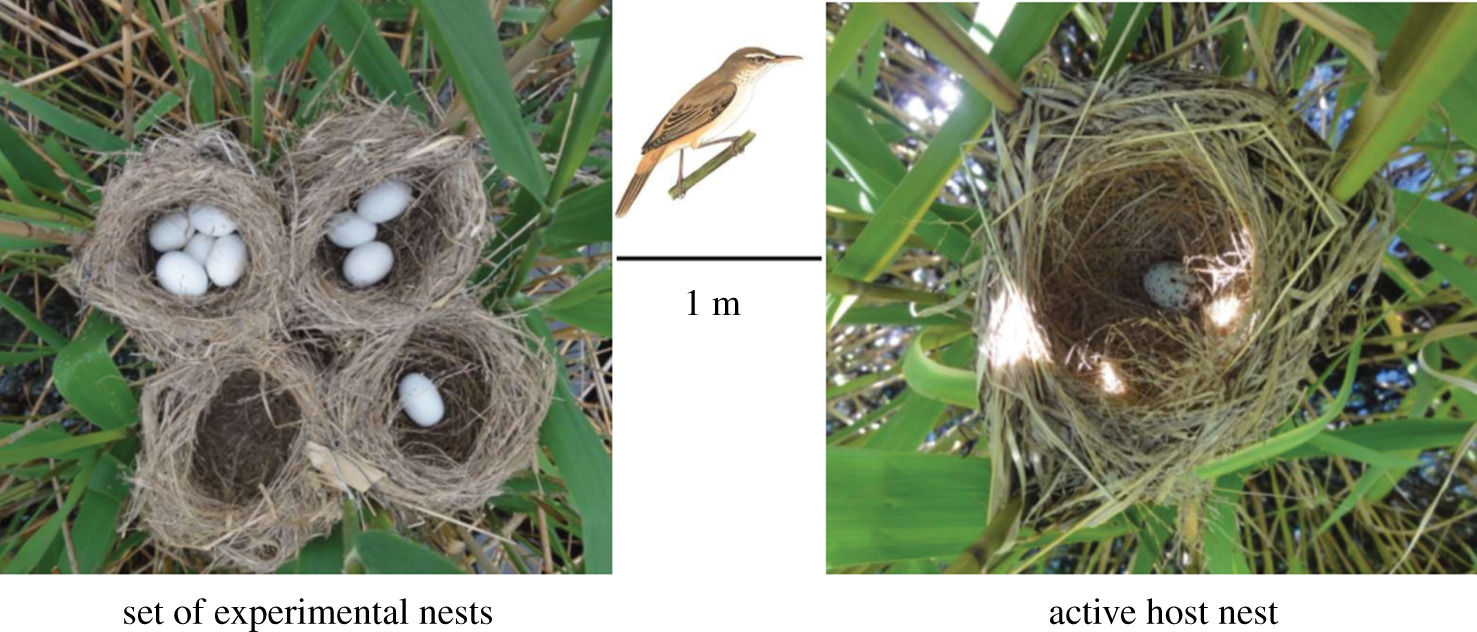
The common cuckoo, Cuculus canorus, is amongst the best known of birds, probably because of its evocative call, synonymous with the advent of summer in Northern Europe. However, this is not its only claim to fame. Its behaviour as a brood parasite, laying its eggs in the nests of other birds, and relying upon then to raise its young, has made it notorious.
Cuckoo egg laying
Cuckoos are known to prefer to lay their eggs soon after the host’s first egg has been laid. The resultant chick will then hatch before most, or all, of the host’s chicks, enabling it to evict host eggs or smaller nestlings from the nest. If you haven’t seen this eviction process do watch this video. Fitness costs incurred by the effort this takes may be compensated for, as cuckoo chicks develop more successfully in nests with no rivals for food.
It has been suggested that cuckoos are able to tell when a host’s nest is unoccupied, or still under construction, and whether eggs are still being laid or incubation has begun, by watching the comings and goings of the parents. But can this brood parasite count the number of eggs laid and reject nests with too many eggs in it? Longwu Wang and colleagues have recently published their answer to this question.
Field Observations
In China the common cuckoo is a brood parasite of small passerines; a favourite host being the Oriental Willow Warbler, Acrocephalus orientalis.

Longwu Wang’s team conducted field observations and field experiments during an 8-year study of cuckoos in the reed beds of Zhalong National Nature Reserve in Heilongjiang, northeast China. During this period 34.3% to 65.5% of Oriental willow warbler nests were parasitized, some by more than one cuckoo.
In all, 245 nests were observed daily. Nests contained between 0 and 6 eggs when a cuckoo laid in them, but 75% of cuckoos preferred nests with one egg or two eggs. For the 33 nests where a second cuckoo laid an egg, a maximum of 2 host eggs was present when the first cuckoo laid and the second cuckoos preferred nests with only 1-2 eggs.
These observations clearly showed that cuckoos preferred nests with very few eggs but did not show how they gauged the number of eggs. It took the second part of their study to do this.
Experimental observations
Empty nests were collected at the end of each season and, the next year, were set out in groups of four. Artificial eggs, mimicking the eggs of the willow warbler, were placed in the nests in a pattern of none, one, three or five eggs. Altogether, 42 experimental sets of nests were observed. The nests were placed close to an active warbler’s nest, but further above the ground so that they were easier for the cuckoos to find.

Cuckoos did lay in the experimental nests, but no cuckoo parasitism was observed in the adjacent real nests, suggesting the location of the artificial nest did prove more attractive.
Off the 32 sets of experimental nests that fooled the cuckoos, the one containing a single egg was the one parasitized in 25 of the sets, and only one cuckoo laid an egg in a nest containing 5 eggs. The nests containing one artificial egg were chosen despite the lack of any warbler activity that could have given a clue to the status of the nest, egg laying and incubation.
These findings confirmed previous studies that have shown that cuckoos are biased towards laying eggs in their host’s nests early in the host’s egg laying period. In addition, the ingenious use of the experimental nests clearly demonstrated that the cuckoos were basing their egg laying decision of the number of eggs in the nest rather than the behaviour of the hosts. Cuckoos could indeed perform a kind of counting.
The advantages the cuckoos gain from laying early in the host’s egg laying period not only give the cuckoo chick a head start over any other nestlings. It is also an advantage as willow warblers are less aggressive in defending their nest from predators early on, whereas they will defend it from attack once a clutch of eggs has been laid. In addition, the authors suggest that willow warblers are less likely to recognise a cuckoo’s egg as different from their own, and reject it, if they have not yet had much experience of the appearance of their own eggs.
This research team had already shown that the common cuckoo lays eggs with unusually thick shells and that these shells enable the egg to retain more heat and experience less fluctuation in temperature than host eggs. This would contribute to faster hatching than host eggs. What other adaptations that favour this parasitic relationship will they unearth in the future?

Comments